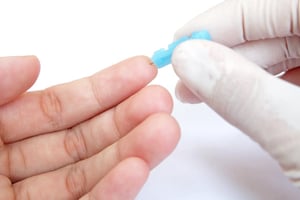Share this
finger prick blood draws: are all lancets created equal?
by Neoteryx Microsampling on Jul 18, 2016 9:00:00 AM
 Fingerstick blood draws are generally quicker to draw and more patient-friendly than blood draws from veins. But, are there considerations in lancet choice and finger prick preparations that could impact patient comfort?
Fingerstick blood draws are generally quicker to draw and more patient-friendly than blood draws from veins. But, are there considerations in lancet choice and finger prick preparations that could impact patient comfort?
Lancet Types
Standard - A standard exposed-blade lancet goes deep into the skin to reach the capillary blood, and it hits pain nerves on its path. Patients must use a new lancet for every prick. Repeated use dulls the blade, making each subsequent prick more painful, as well as introducing risk of infection.
Safety - Safety-type lancets have spring-loaded blades that automatically retract. Safety lancets are more hygienic because the blade only comes out when it punctures the skin, and then it retracts. After retraction, the blade doesn't pose a hazard for either punctures or contamination. This type of lancet has the advantage over the exposed-blade lancet of being more user-friendly for at-home blood tests by those who are squeamish about finger pricks or have needle phobia, since the blade is never seen.
Vacuum - Another type of lancet has a built-in vacuum. These lancets penetrate the skin 20% as deep as standard lancets and pull out the blood from the capillaries via vacuum. Because capillaries are at different depths in different parts of the body, vacuum-equipped lancets enable the user to draw blood from sites other than fingertips.
Laser - Laser lancets were used about 15 years ago, and they fell out of favor because they essentially bored a hole into the fingertip, which is much more painful and injurious than traditional blade lancets.
Preparations to Help Reduce Fingerstick Blood Draw Pain
When obtaining a sample of capillary blood, a finger prick blood draw is a common method. Even though it's a straightforward process, there are tweaks that can help patients better tolerate this type of blood draw. Both the lancet type and the preparation for and pricking of the finger can affect patients' pain tolerance. It is important to remember, though, that patients must always follow the lancet manufacturer's instructions step-by-step.
1. Washing hands with antibacterial soap instead of using alcohol. Alcohol wipes dry out and constrict the skin in such a way that the subsequent puncture is more painful and the blood doesn't flow out smoothly.
2. Pricking the side of the finger helps with the perception of pain because the fingertips aren't damaged and painful after the prick.
3. Selecting a lancet with a smaller gauge can also help reduce pain to what some manufacturers describe as a barely perceptible level. Lancet depth can also impact pain levels, however it is important to note that blade length will affect the amount of blood drawn. Therefore the number of blood drops required for the test must also be considered when selecting a lancet.
Let us know if your patients have a preferred lancet type and any finger prick hints.

Share this
- Microsampling (206)
- Research, Remote Research (119)
- Venipuncture Alternative (105)
- Clinical Trials, Clinical Research (83)
- Mitra® Device (73)
- Therapeutic Drug Monitoring, TDM (51)
- Dried Blood Spot, DBS (39)
- Biomonitoring, Health, Wellness (30)
- Infectious Disease, Vaccines, COVID-19 (24)
- Blood Microsampling, Serology (23)
- Omics, Multi-Omics (21)
- Decentralized Clinical Trial (DCT) (20)
- Specimen Collection (18)
- Toxicology, Doping, Drug/Alcohol Monitoring, PEth (17)
- Skin Microsampling, Microbiopsy (14)
- hemaPEN® Device (13)
- Preclinical Research, Animal Studies (12)
- Pharmaceuticals, Drug Development (9)
- Harpera Device (7)
- Industry News, Microsampling News (5)
- Antibodies, MAbs (3)
- Company Press Release, Product Press Release (3)
- Environmental Toxins, Exposures (1)
- July 2025 (1)
- May 2025 (1)
- April 2025 (2)
- December 2024 (2)
- November 2024 (1)
- October 2024 (3)
- September 2024 (1)
- June 2024 (1)
- May 2024 (1)
- April 2024 (4)
- March 2024 (1)
- February 2024 (2)
- January 2024 (4)
- December 2023 (3)
- November 2023 (3)
- October 2023 (3)
- September 2023 (3)
- July 2023 (3)
- June 2023 (2)
- April 2023 (2)
- March 2023 (2)
- February 2023 (2)
- January 2023 (3)
- December 2022 (2)
- November 2022 (3)
- October 2022 (4)
- September 2022 (3)
- August 2022 (5)
- July 2022 (2)
- June 2022 (2)
- May 2022 (4)
- April 2022 (3)
- March 2022 (3)
- February 2022 (4)
- January 2022 (5)
- December 2021 (3)
- November 2021 (5)
- October 2021 (3)
- September 2021 (3)
- August 2021 (4)
- July 2021 (4)
- June 2021 (4)
- May 2021 (4)
- April 2021 (3)
- March 2021 (5)
- February 2021 (4)
- January 2021 (4)
- December 2020 (3)
- November 2020 (5)
- October 2020 (4)
- September 2020 (3)
- August 2020 (3)
- July 2020 (6)
- June 2020 (4)
- May 2020 (4)
- April 2020 (3)
- March 2020 (6)
- February 2020 (3)
- January 2020 (4)
- December 2019 (5)
- November 2019 (4)
- October 2019 (2)
- September 2019 (4)
- August 2019 (4)
- July 2019 (3)
- June 2019 (7)
- May 2019 (6)
- April 2019 (5)
- March 2019 (6)
- February 2019 (5)
- January 2019 (8)
- December 2018 (3)
- November 2018 (4)
- October 2018 (7)
- September 2018 (6)
- August 2018 (5)
- July 2018 (8)
- June 2018 (6)
- May 2018 (5)
- April 2018 (6)
- March 2018 (4)
- February 2018 (6)
- January 2018 (4)
- December 2017 (2)
- November 2017 (3)
- October 2017 (2)
- September 2017 (4)
- August 2017 (2)
- July 2017 (4)
- June 2017 (5)
- May 2017 (6)
- April 2017 (6)
- March 2017 (5)
- February 2017 (4)
- January 2017 (1)
- July 2016 (3)
- May 2016 (1)
- April 2016 (2)


Comments (3)